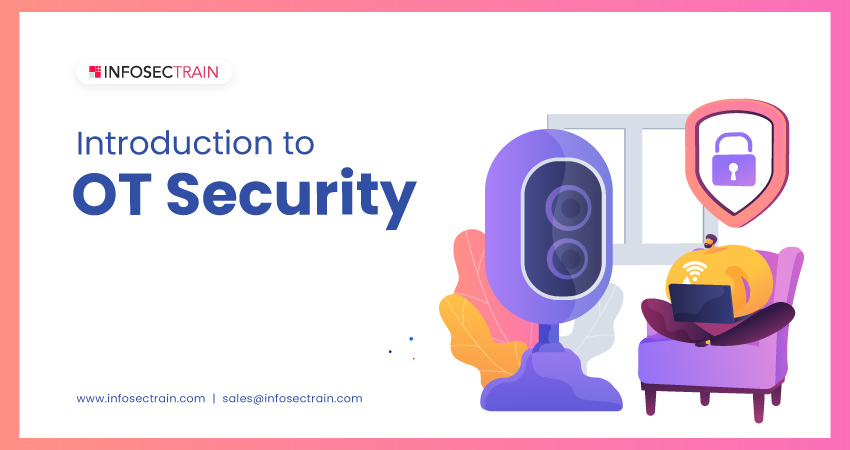Introduction to OT Security
Operational Technology (OT) security is the practice of protecting industrial control systems (ICS) from cyber threats that could compromise their availability, safety, and integrity. These systems play a crucial role in managing, overseeing and controlling industrial processes.

OT security is critical for ensuring the availability of critical infrastructure and services, as well as the safety of people and the environment.
With the increasing convergence of IT and OT systems, there is a greater risk of cyberattacks targeting critical infrastructure. As a result, understanding the importance of OT security, common OT security challenges and best practices are critical to ensuring the safety and reliability of critical services and prevent OT attacks.
Importance of OT Security:
OT systems are critical to the continued operation of critical services and infrastructure. Successful OT attacks on these systems can cause service disruptions, physical damage to equipment, financial loss, environmental damage, and even human death. As IT and OT systems become more interconnected, the attack surface expands, necessitating proactive OT security.
OT Security vs IT Security:
- OT cyber security aims to ensure the safety, reliability, and availability of critical infrastructure, IT security focuses on protecting data, confidentiality, and integrity.
- OT systems use specialized hardware, software, and protocols designed for specific industrial applications. IT systems prioritize data processing, storage, and communication, with an emphasis on data protection and efficient data management.
- OT systems typically have longer life cycles and may not receive regular security updates, making them more susceptible to vulnerabilities. IT systems typically have shorter life cycles, and they receive more frequent security updates to address emerging threats and vulnerabilities.
- OT security adheres to industry specific standards and regulations, such as IEC 62443 for industrial automation and control systems and NERC CIP for the electric power industry.
- IT security follows more general cybersecurity standards and frameworks, such as ISO/IEC 27001, NIST Cybersecurity Framework, and GDPR for data protection.
Despite the differences in OT security vs IT security, and their distinct focuses and challenges, the growing convergence of IT and OT systems means that the two disciplines are becoming increasingly intertwined. As a result, it is critical to implement a comprehensive security strategy that addresses both IT and OT security concerns.
Common OT Security Challenges:
Securing OT environments presents a number of common OT security challenges, including:
- Legacy equipment: Older OT systems often lack built in security features and may not be compatible with modern security technologies.
- Interoperability: The wide range of proprietary systems and protocols used in OT environments can make it difficult to implement a unified security strategy.
- Patch management: OT systems often require continuous operation, making it difficult to schedule downtime for security updates or patches.
- Workforce awareness: Many OT employees lack cybersecurity training, making it difficult for them to identify and minimize threats.
Threats targeting OT Systems:
Threats targeting OT systems can range from nation-states to cybercriminals, hacktivists, and insider threats. Common attack vectors include:
- Malware: Malicious software that can infect OT devices and systems, either through direct installation or network propagation. Malware can perform various malicious actions, such as stealing data, deleting files, encrypting data, disrupting operations, or causing physical damage. Examples of malware that have targeted OT systems include Stuxnet, Industroyer, Triton, and EKANS.
- Ransomware: Ransomware is a type of malware that encrypts the data or files on a system and demands a ransom for their decryption. Ransomware can affect both IT and OT systems and cause significant operational and financial losses. Ransomware can also threaten to leak or destroy the data if the ransom is not paid. Some examples of ransomware that target OT systems are LockerGoga, Ryuk, Maze, and REvil.
- Denial-of-service (DoS) attacks: DoS attacks are cyberattacks that aim to overwhelm or disrupt a system or network by sending a large amount of traffic or requests. DoS attacks can affect both IT and OT systems and cause them to slow down or crash. DoS attacks can also prevent legitimate users from accessing or using the system or network. Some examples of DoS attacks that target OT systems are SYN floods, UDP floods, ICMP floods, and TCP reset attacks.
- Advanced persistent threats (APTs): APTs are stealthy and sophisticated cyberattacks that aim to infiltrate a system or network and remain undetected for a long period of time. APTs can use various techniques to evade detection and defense mechanisms, such as encryption, obfuscation, polymorphism, and lateral movement. APTs can target both IT and OT systems and perform various malicious activities, such as reconnaissance, data exfiltration, sabotage, or espionage. Some examples of APTs that target OT systems are Dragonfly, APT33, APT34, and APT41.
- Insider threats: Insider threats targeting OT systems are cyber-attacks that are carried out by authorized users of a system or network who abuse their access privileges or credentials. Insider threats can be intentional or unintentional and can affect both IT and OT cyber security. Insider threats can cause various damages to a system or network, such as data theft, data manipulation, data destruction, system tampering, or system sabotage. Some examples of insider threats that target OT systems are disgruntled employees, contractors, vendors, or competitors.
OT Security Tools & Best Practices:
To address the challenges and protect OT systems from cyberattacks, organizations should adopt the following OT cyber security best practices and OT Security tools:
- Conduct a risk assessment: Organizations should identify and prioritize the assets, threats, and vulnerabilities that affect their OT systems. They should also evaluate the potential impact and likelihood of different attack scenarios and determine the appropriate mitigation strategies and controls.
- Implement a defense-in-depth strategy: Organizations should apply multiple layers of security measures to protect their OT systems from various angles. These measures may include physical security, network segmentation, firewall rules, access control policies, encryption protocols, antivirus software, intrusion detection systems, backup and recovery plans, and incident response procedures.
- Monitor and audit OT activities: Organizations should continuously monitor and log the events and activities that occur on their OT networks. They should also perform regular audits and reviews to verify the compliance and effectiveness of their security policies and controls. They should also use threat intelligence and analytics tools to identify and respond to emerging threats and trends.
- Educate and train OT staff: Organizations should raise the security awareness and skills of their OT staff by providing them with regular training sessions, workshops, simulations, or exercises. They should also establish clear roles and responsibilities for OT staff regarding security issues and incidents. They should also foster a culture of security among their OT staff by encouraging them to report any suspicious or abnormal behaviours or events.
- Collaborate with IT staff: Organizations should foster close collaboration between their IT and OT staff by creating cross-functional teams, committees, or working groups. They should also align their IT and OT security tools, policies and objectives and share best practices and lessons learned. They should also leverage the expertise and resources of their IT staff to enhance their OT cyber security capabilities.
Final thoughts:
Importance of OT security is increasing among organizations. OT cyber security is a vital aspect of ensuring the reliability and safety of critical infrastructure and services that depend on OT systems. Organizations should adopt a proactive and holistic approach to secure their OT systems from cyberattacks by following the best practices outlined above. By doing so, they can reduce the risks and costs associated with OT security incidents and improve their operational efficiency and performance.







 1800-843-7890 (India)
1800-843-7890 (India)